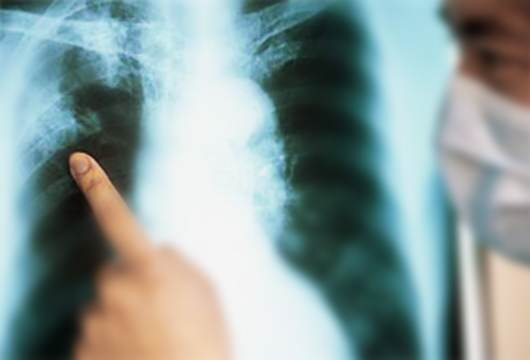Tuberculosis
- font size decrease font size increase font size
 Every 20 seconds, someone dies from the serious condition of tuberculosis (TB), despite the fact that it is a treatable ailment. It’s a cruel illness that affects the most vulnerable, the sick and the poor.
Every 20 seconds, someone dies from the serious condition of tuberculosis (TB), despite the fact that it is a treatable ailment. It’s a cruel illness that affects the most vulnerable, the sick and the poor.
TB is an infectious disease caused by Mycobacterium tuberculosis, which most commonly affects the lungs, but TB bacteria can attack any part of the body such as the kidney, spine, and brain.
TB is spread from person to person via droplets from the throat and lungs of people with the active respiratory disease. When they cough, sneeze, speak, or sing, people nearby may breathe in these bacteria and become infected. They are most likely to spread the bacteria to people they spend time with every day, such as family members, friends, coworkers, or schoolmates. Often, TB spreads within a family who live in the same house.
Some people develop TB disease within weeks after becoming infected, while others may get sick years later. Usually, TB develops slowly.
So, if you think you have been exposed to someone with TB disease, contact your healthcare provider to see if you should be tested for TB infection.
Symptoms
The symptoms of tuberculosis (TB) depend on where the infection occurs.
Typical symptoms include:
- • having a persistent cough for more than three weeks that brings up phlegm (sputum or blood)
- • weight loss{media load=media,id=84,width=200,align=left,display=inline}
- • chest pains
- • night sweats
- • high temperature (fever)
- • weakness, tiredness and fatigue
- • loss of appetite
If you have a cough that lasts more than three weeks or if you cough up blood, you should see a doctor/ healthcare provider. At this point, you could possibly spread TB bacteria to others as well.
Latent TB Infection and TB Disease
Once infected the active bacteria would have to multiply in your body and cause active TB disease. In most healthy people, the immune system, the body's natural defence against infection, kills the bacteria and you have no further symptoms.
latent TB infection
Sometimes the immune system fails to kill the bacteria, but manages to prevent it from spreading in the body. This means you show no symptoms of TB, but the bacteria is still in your body ‘sleeping’. This is known as latent TB. People with latent TB infection are not infectious and cannot spread TB to others. However, latent TB could develop into an active TB infection at a later date, particularly if the immune system becomes weakened.
Active TB disease
If the immune system fails to kill or contain the infection, it can spread to the lungs or other parts of the body and symptoms will develop within a few weeks or months. This is known as active TB.
Testing for TB Infection
Anyone can catch TB. People whose immune systems are weak, especially those with HIV infection, are at a greater risk of developing the disease. Early detection of TB is essential to improving health outcomes for people with TB, and to reduce TB transmission more effectively.{media load=media,id=85,width=200,align=left,display=inline}
There are two kinds of tests that are used to detect TB bacteria in the body:
- • TB skin test (TST) - Mantoux tuberculin skin test is performed by injecting a small amount of tuberculin into the skin in the lower part of the arm. A person given the skin test must then return within 48 to 72 hours. The health professional will then look for a raised, hard area or swelling, and if present, measure its size using a ruler.
- • and TB blood tests - interferon-gamma release assays or IGRAs) measure how the immune system reacts to the bacteria that cause TB by testing the person’s blood in a laboratory. IGRAs tests, unlike the TB skin tests, are not affected by prior BCG vaccination and are not expected to give a false-positive result in people who have received BCG vaccine.
If a positive reaction to either of the tests is made, you will be referred for a medical evaluation (which involves physical examination, chest x-ray, and other laboratory tests) to see if you have latent TB infection or active TB disease.
Treatment
Treatment for tuberculosis (TB) depends on which type you have.
If you have latent TB infection, your health care provider may want you to be treated. The decision about taking treatment for latent TB infection will be based on your chances of developing TB. Because there are less bacteria in a person with latent TB infection, treatment is much easier. The medications used to treat latent TB infection include:
- • isoniazid (INH)
- • rifampin (RIF)
- • rifapentine (RPT)
Pulmonary TB is treated using a combination of antibiotics, usually for a span of 6 to 9 months. First-line anti-TB agents that form the core of treatment regimens include:
- • isoniazid (INH)
- • rifampin (RIF)
- • ethambutol (EMB)
- • pyrazinamide (PZA)
The usual course of treatment is:
- • two antibiotics – isoniazid and rifampicin – every day for six months
- • two additional antibiotics – pyrazinamide and ethambutol – every day for the first two months
If you are diagnosed with pulmonary tuberculosis (TB), which affects the lungs, you will be contagious up to about two to three weeks into your course of treatment.
It is therefore paramount to take some basic precautions to stop TB spreading to your family and friends. These precautions are:
- • stay away from work or school until your healthcare provider advises otherwise
- • always cover your mouth when coughing, sneezing or laughing
- • carefully dispose of any used tissues in a sealed plastic bag
- • open windows when possible to ensure a good supply of fresh air
- • do not sleep in the same room as other people because you could cough or sneeze in your sleep without realising it
Treatment completion is determined by the number of doses ingested over a given period of time. There are modifications that are usually made under special circumstances such as people with HIV infection, drug resistance (MDR-TB, XDR-TB), pregnancy, or treatment of children.
It is very important to finish the medicine, and take the drugs exactly as prescribed.
- • If you stop taking the drugs too soon, you’ll become sick again.
- • If you do not take the drugs correctly, the bacteria that are still alive may become resistant to those drugs. TB that is resistant to drugs [Multi-drug resistant tuberculosis (MDR-TB) - a resistance to two antibiotics: Extensively drug resistant tuberculosis (XDR-TB) -a resistance to three or more antibiotics] is harder and more expensive to treat.
Side effects
In rare cases, these antibiotics can cause damage to the liver, ear or the eyes, which can be serious. Therefore it is important to include supervised treatment, which will involve regular contact with your healthcare provider. Remember to contact your healthcare professional immediately if you have any of the following symptoms:
- • feeling sick
- • yellowing of your skin and darkening of your urine
- • unexplained fever – a temperature of 38ºC or above
- • tingling or numbness in your hands or feet • skin rash or itchy skin
- • changes to your vision
- • hearing loss
The vaccine
If you need to be vaccinated against TB, you will first be given a Mantoux skin test. This checks how sensitive you are to the TB vaccine.
If you have a negative result to the Mantoux test, you will be given the vaccine as a single injection.
Who needs BCG vaccination?
BCG, a vaccine developed more than 90 yrs ago is still effective in protecting mainly children from contracting TB.{media load=media,id=86,width=200,align=left,display=inline}
BCG is recommended for:
- • all babies up to one year old who are born in areas where the rates of TB are high
- •older children who were not vaccinated against TB when they were babies, and are at high risk.
- • anyone under 16 who has been in close contact with someone who has pulmonary TB
- •people under 35 years of age whose occupation puts them at increased risk of exposure to TB.
Whether you are a healthcare professional, patient or individual, You can stop TB, Save lives.
Useful Links:
